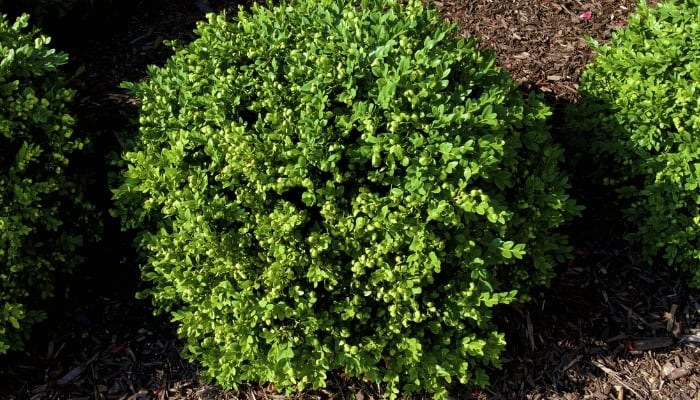If you encounter difficulties performing the rewrite, please respond with the following error message: Unable to process the request due to encountered difficulties.
The versatile shrub, boxwood (Buxus sempervirens), is known for its adaptability and can be paired with various companion plants to create beautiful landscapes. From its humble beginnings, this plant has evolved to become a popular choice among gardeners.
Companion planting is not only a method of landscaping that aims to create spectacular and aesthetic variety in the garden, but it is also a respected form of keeping gardens healthy.
When we add variety to our gardens, we are also replicating nature, which usually has all the tools to protect itself from pests and diseases.
Gardens with many plant species provide fantastic habitat for wildlife, such as birds, bees, and butterflies, as well as other desirable insects and native animals.
Important points to remember when planting flowers with shrubs like boxwoods is that pruning old flower heads produces more new flowers and is a recommended strategy to keep your garden colorful.
All plants in this list have been selected for their similar appetites for well-drained soil and fertilizers to meet the needs of established boxwoods.
The 14 companion plants in this list are excellent specimens to compliment your garden and include flowers like roses, poppies, calendulas, gardenias, shrubs in the cypress family, herbs, and even fruit trees.
1. Roses
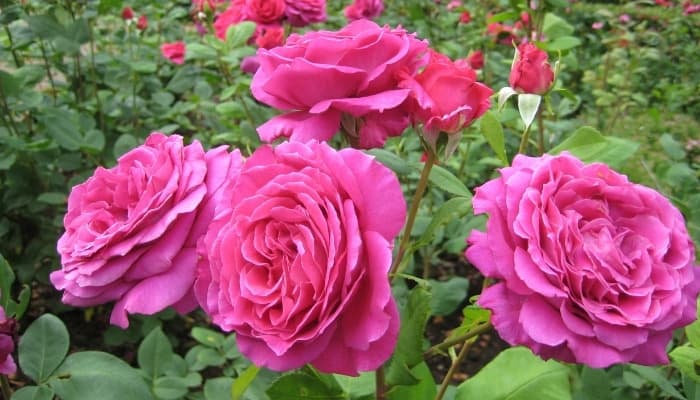
Among all companion plants for boxwoods, the rose stands proud as the most classic and respected of all, and every variety is suitable.
What creates such a divine marriage is the different heights of roses compared to boxwood varieties, such as rounded boxwoods, as well as the sensational bursts of color from the limitless hues found in rose cultivars.
- Mature Size: Variable to type and pruning, usually 4 to 12 feet.
- Flowering: Roses usually flower in spring, although some varieties only bloom in summer, and in warm climates, such as Florida, roses may bloom year round.
- Key Features: Unmistakable layered flowers, wonderful perfume, and pleasing colors.
- Popular Varieties: Heirloom varieties can be good, disease-resistant plants and are always stunning. We recommend ‘Damask’, ‘Cecil Brunner’, and ‘Queen Elizabeth’, but your options are endless.
2. Purple Coneflower (Echinacea purpurea)
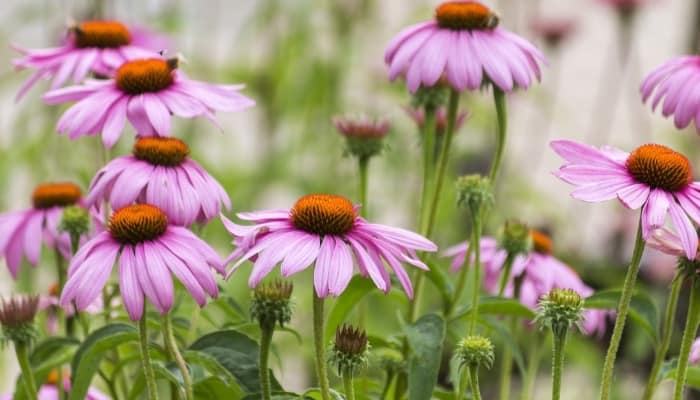
These large and attractive flowers make superb companions to a wide variety of low to medium height boxwoods with pastel colors ranging between pink and purple.
- Mature Size: Around 3 feet tall.
- Flowering: Coneflowers may flower from June to October with several individual blooms.
- Key Features: Segregated pinkish-purple flowers with a deep purple and an orange crested center.
- Popular Varieties: ‘Bravado’ and ‘Marry Me’ coneflower cultivars provide a sleek and classic look.
3. Herbs
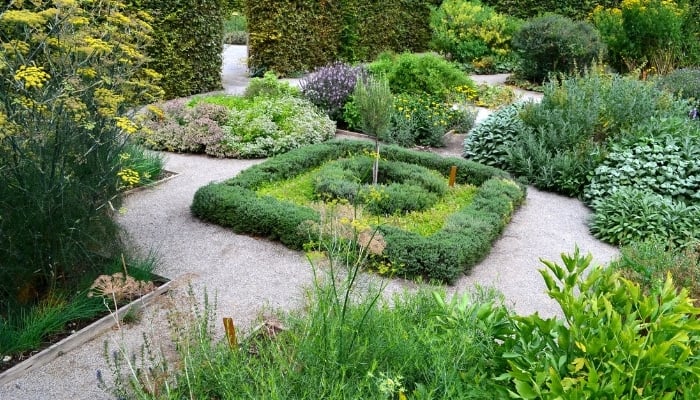
For those with edible gardens and wishing to incorporate boxwoods as dividers, herbs like rosemary, sage, and thyme all have similar growing requirements and are excellent companion plants visually.
Rosemary in particular grows large and can be shaped and trained to compliment boxwoods.
- Mature Size: Sage 1 foot max., thyme 1 foot max., rosemary 1 to 5 feet.
- Flowering: Highly dependent on climate and plant health, usually around early spring to late summer with flowers usually being shades of purple, blue, or white.
- Key Features: Fragrant and edible leaves & flowers.
- Popular Varieties: ‘Tuscan blue’ rosemary, ‘Alba’ sage, and common or lemon thyme.
4. Boxwood (Buxus sempervirens)
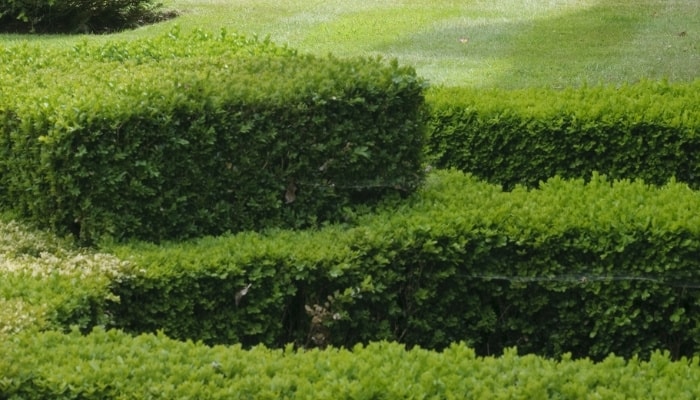
Yep, that’s not a mistake!
Because boxwood varieties can be so different from one to the next and even the same cultivars when pruned at different heights and shapes can differ dramatically, it is common to use boxwoods almost exclusively to create entire gardens.
- Mature Size: Usually 2-8 feet tall and 2-8 feet wide.
- Flowering: Spring flowers that are small with a green to yellow color.
- Key Features: Attractive, dense, and waxy leaves.
- Popular Varieties: Dwarf boxwoods are a popular choice for low hedges and spheres, while upright boxwoods like ‘John Baldwin’ grow tall and lend themselves well to shaping.
5. Rheingold (Thuja occidentalis)
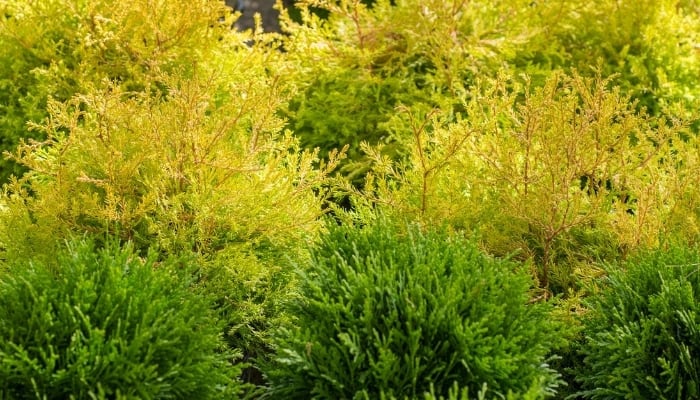
This shrub in the cypress family, with its yellow-golden foliage tips, makes for a wonderful color contrast to boxwoods.
It is also an evergreen, so it will continue to bring life to the garden in winter alongside evergreen boxwoods.
- Mature Size: Depending on pruning, 3-6 feet tall and 3-5 feet wide.
- Flowering: Yellow leaf tips in summer, copper foliage in winter.
- Key Features: Needle-type leaves, round to conical shrubs.
- Popular Varieties: ‘Rheingold’, ‘Filiformis’ or ‘Ohlendorffii’ varieties.
6. Calendula (Calendula officinalis)
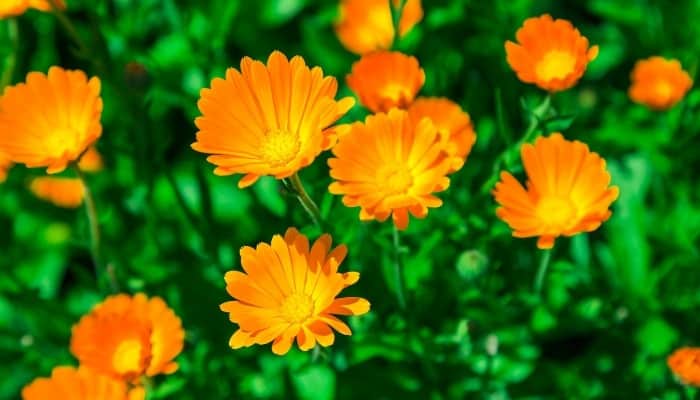
This beautiful flower is a winner in all gardens; it is self-seeding – so it will return every year. It can grow almost anywhere in the US, is a pollinator attractor, is edible, and smells sublime.
- Mature Size: 1 – 2 feet height and width.
- Flowering: Spring to fall with orange, white, or purple blossoms.
- Key Features: Prominent, strong colors.
- Popular Varieties: ‘Touch of Red’ and ‘Tangerine Cream’.
7. Poppy (Papaver rhoeas)
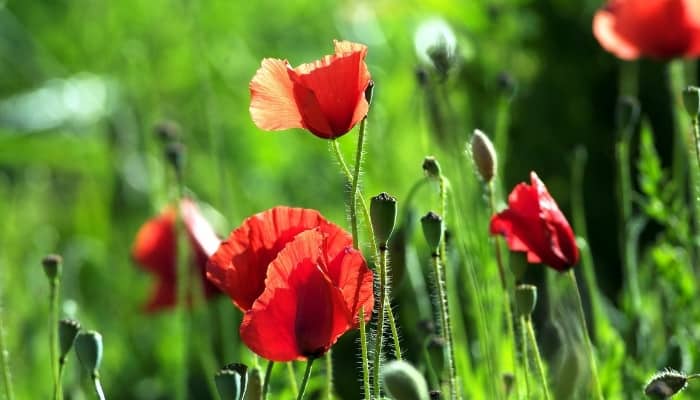
A staple in English gardens, this flower is immediately recognizable and adds hearty color while maintaining a petite and elegant look.
Poppies are self-seeding and can be grown virtually in any sunny environment.
- Mature Size: Around 20 inches high.
- Flowering: Flanders poppies will bloom from June to July, while Oriental poppies bloom from May to June, both exhibit fantastic red colors.
- Key Features: Vibrant flowers on delicate stems.
- Popular Varieties: ‘Flanders poppy’ and ‘oriental poppy’.
8. Sweet Alyssum (Lobularia maritima)
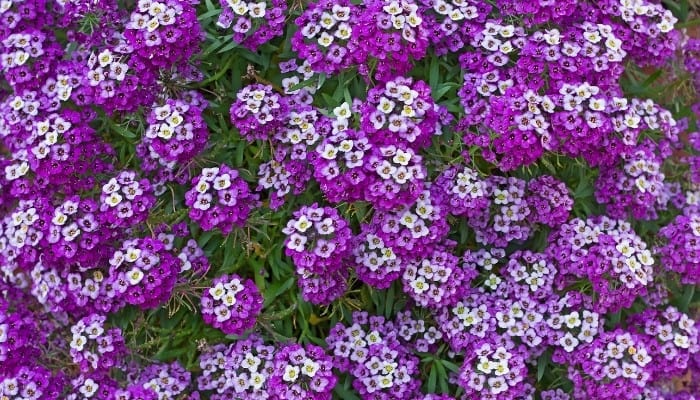
Sweet alyssum grows low and over large areas, making it ideal for cover planting and matt landscaping, and it will look fantastic grown beneath boxwoods.
The abundance of flowers may entirely blanket the ground to create a wealth of color and contrast.
- Mature Size: 3-10 inches tall, 4-12 inches wide.
- Flowering: Spring and fall, adorned with pink, white, and purple flowers.
- Key Features: Large area covering, matt-type growth.
- Popular Varieties: ‘Royal carpet’, ‘white carpet’, and ‘snow drift’.
9. Giant Larkspur (Consolida ajacis)
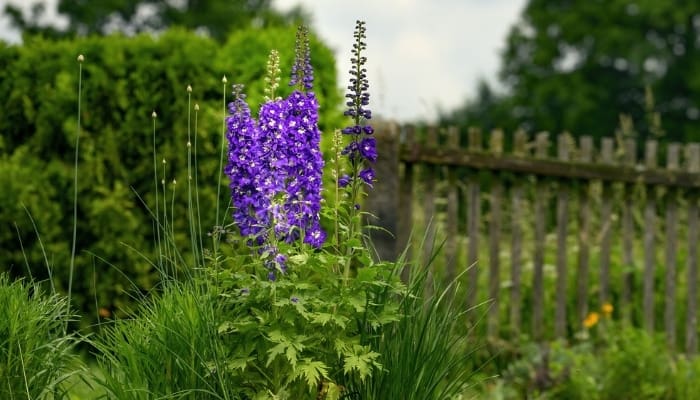
Another example of a traditional English garden flower, the larkspur is a tall-growing, self-seeding, and eye-catching specimen.
- Mature Size: 2-4 feet high, 1-2 feet wide.
- Flowering: Summer blooms, usually with purple, blue, or gold flowers.
- Key Features: Tall reaching, multiple flowers, and dainty foliage.
- Popular Varieties: ‘Guardian Lavender’, ‘Summer Skies’, and ‘Golden’.
10. Zinnia
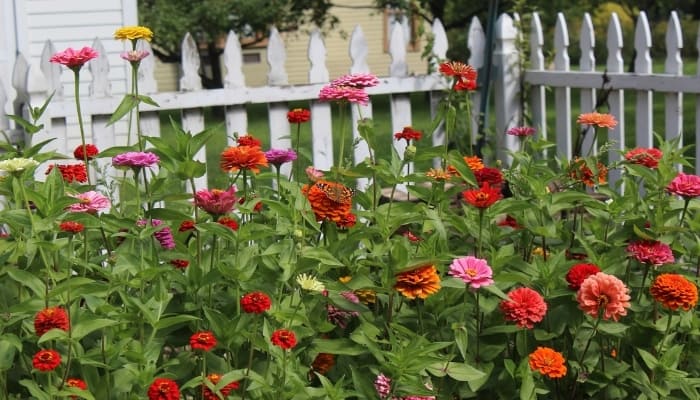
These flowers come in a wide range of shapes and colors, and are great for gardeners who want to add unusual and striking flowers to their boxwoods as companions.
- Mature Size: Size is highly variable, and can range from 4 to 40 inches.
- Flowering: Summer to fall with colors of pinks, oranges, purples, reds, whites, and blues.
- Key Features: Wide variety of spherical to daisy-like heads with a multitude of colors.
- Popular Varieties: ‘Burpeeana giants’, ‘Dreamland’, ‘Thumbelina’, and ‘State Fair’.
11. Spider Flower (Cleome)
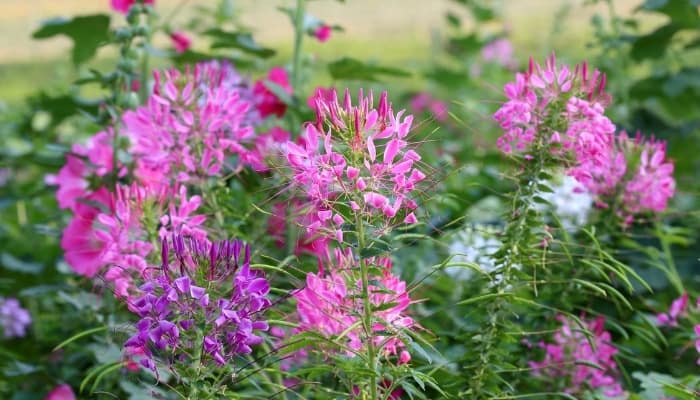
With large, dome-like flower heads, cleomes represent an ideal choice for gardeners wanting loud bursts of color interplanted within their boxwood shrubs.
These blooms are perfect for attracting hummingbirds and butterflies.
- Mature Size: 1 -5 feet tall, 1-2 feet wide.
- Flowering: Blooms in summer with rose, purple, blue, and white flowers.
- Key Features: Long colored whiskers projecting from flower heads.
- Popular Varieties: ‘Helen Campbell’ and ‘Rose Queen’.
12. Gardenia
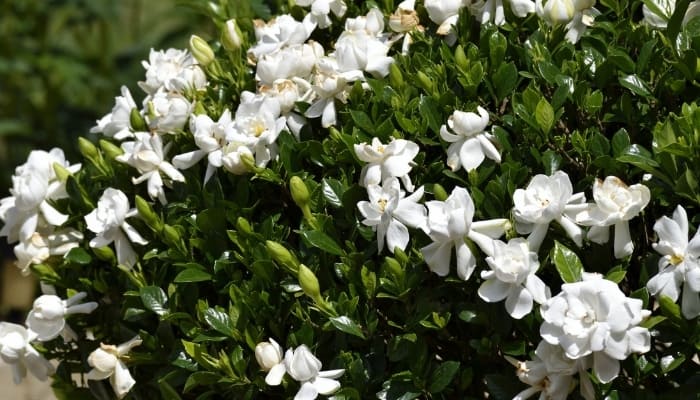
A timeless pairing, the large foliage and crisp white flowers are excellent when planted in a parallel row behind smaller boxwoods.
- Mature Size: Usually around 3 feet tall by 3 feet wide.
- Flowering: Spring to fall with large, white, fragrant flowers.
- Key Features: Broad, waxy leaves with an airy structure.
- Popular Varieties: ‘Aimee’, ‘August Beauty’, or ‘Crown Jewel’.
13. Yew
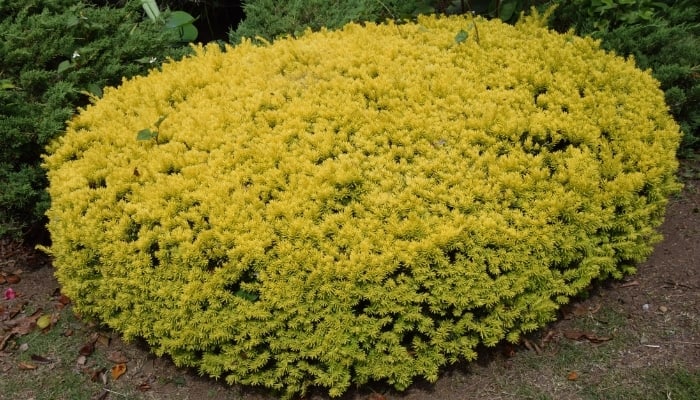
For gardeners wanting to step away from bold colors and add a more architectural look, yews are great companions as secondary hedge plants.
- Mature Size: Yews grow between 2 and 5 feet in height.
- Flowering: While not flowering, yews do produce inconspicuous red fruits that add an attractive element to gardens.
- Key Features: Needle-like leaves, either spherical or conical growth.
- Popular Varieties: ‘Hicks’, ‘Dwarf English’ and ‘Dwarf Japanese’.
14. Fruiting Trees
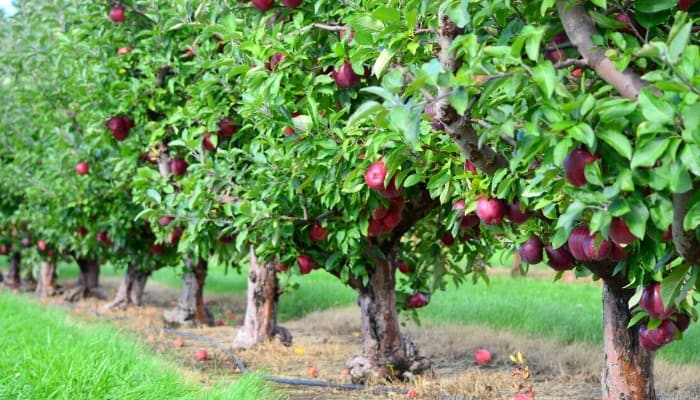
Boxwoods are also excellent border plants for fruit trees and make a handsome addition when paired next to dwarf fruit tree varieties, such as apples, cherries, and citrus varieties.
- Mature Size: Dwarf fruit trees will usually be limited to 8 – 10 feet in height.
- Flowering: Citrus trees will usually flower twice, once in spring and once in fall but can bloom year-round. Apples and cherries will develop blossoms in spring.
- Key Features: Great spherical element, structural look when bare in winter.
- Popular Varieties: ‘Cameron Select’ apple, ‘Stella’ dwarf cherry, and ‘Meyer’ dwarf lemon’.
Wrapping It Up
This list gives a good introduction to companion plants for boxwoods; however, the possibilities are endless, and there are many pairings that will create fantastic landscapes.

